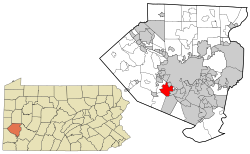
Back Mount Lebanon (lungsod) CEB Mount Lebanon Township, Pennsylvania Welsh Mount Lebanon (Pennsylvania) German Municipio de Mt. Lebanon Spanish Mount Lebanon French Mount Lebanon, Pennsilvani HT Mt. Lebanon, Pennsylvania ID Mount Lebanon (Pennsylvania) Italian マウントレバノン (ペンシルベニア州) Japanese 마운트레버넌 (펜실베이니아주) Korean
Mt. Lebanon, Pennsylvania | |
|---|---|
 Uptown Mt. Lebanon along Washington Road (Rt. 19 Truck) | |
| Motto: "A Community with Character" | |
 Location in Allegheny County and in Pennsylvania | |
| Coordinates: 40°22′30″N 80°3′0″W / 40.37500°N 80.05000°W | |
| Country | United States |
| State | Pennsylvania |
| County | Allegheny |
| Named for | Cedrus libani (Cedar of Lebanon) |
| Government | |
| • Body | Commission |
| • President of Commission | Anne Swager Wilson (D) |
| Area | |
• Total | 6.08 sq mi (15.75 km2) |
| • Land | 6.08 sq mi (15.74 km2) |
| • Water | 0.00 sq mi (0.01 km2) |
| Population (2020) | |
• Total | 34,075 |
| • Density | 5,604.44/sq mi (2,163.49/km2) |
| Time zone | UTC-5 (EST) |
| • Summer (DST) | UTC-4 (EDT) |
| ZIP code | 15228 |
| FIPS code | 42-003-51696 |
| Website | www.MtLebanon.org |
Mt. Lebanon Historic District | |
| NRHP reference No. | 14000813[2] |
| Added to NRHP | September 30, 2014 |
Mt. Lebanon (locally /ˈlɛb.ə.nən/) is a township with home rule status in Allegheny County, Pennsylvania, United States. The population was 34,075 at the 2020 census. It is a suburb of Pittsburgh. Established in 1912 as Mount Lebanon, the township was a farming community. With the arrival of the first streetcar lines and the development of the first real estate subdivision, both in 1901, it became a streetcar suburb, offering residents the ability to commute to Downtown Pittsburgh.[3] Furthermore, the opening of the Liberty Tunnel in 1924 allowed easy automobile access to Pittsburgh. In 1975, the renamed Mt. Lebanon adopted one of the first home rule charters in Pennsylvania.[4][5]
- ^ "2016 U.S. Gazetteer Files". United States Census Bureau. Retrieved August 13, 2017.
- ^ "Weekly list of actions taken on properties: 9/29/14 through 10/03/14". National Park Service. October 10, 2014. Retrieved February 3, 2015.
- ^ "Mt. Lebanon History & Information". Archived from the original on July 3, 2009. Retrieved October 9, 2009.
- ^ Pennsylvania Code Title 302, Sec. 27.1-101 et seq. Archived September 13, 2011, at the Wayback Machine
- ^ Mtlebanon.org Archived September 27, 2007, at the Wayback Machine